You can heat a living space 100 1. Which heating system to choose. What can be overclocked
Heating in a living space is very an important condition for life. There are several types of heating systems and heating devices used in them. Each has its own advantages and disadvantages.
Gas boilers
The water heating system is the most common for heating residential premises. Its meaning lies in the use of a coolant based on the circulation of water in the system.
Most of your heat loss is through your head, so wear a light, comfortable hat or other sleeping head. Use sleeping bag, if you have one. Wool is an amazing insulator, so pairing a wool blanket with a cotton sheet and even a mediocre sleeping bag can give you a very warm bed. If the fur makes you itch, fold blanket with cotton sheet on top and bottom. Use fur or fleece if you have it. Both are excellent insulators and can add some comfort.
Food and drink for warmth and safety
Sleeping in a group allows you to share body heat. If you have a tent awning installed, this perfect time to use it. A calorie-dense sleep snack can help you become your own natural source of warmth. Your body will need more calories to stay warm. If you are active, your calorie needs will increase even more. Eating increases your metabolism, which creates additional internal heat.
It is often based on a gas boiler, which can be wall-mounted or floor-mounted. The wall-mounted boiler is a thermoblock that includes an expansion and automatic system.
Such boilers are double-circuit. The floor-standing boiler is single-circuit and includes a pump that supplies heated water to the heating system.
Make sure to keep hydrated. Drink plenty of fluids. Hot drinks, such as tea or hot chocolate, can act as hand warmers as you drink and warm you up from the inside out. They also add variety for emergency nutrition. You can melt snow for water if necessary using one of these. You may want to before drinking. Avoid large amounts of alcohol! A sip or two is one thing, but some people think a little is better. The "warming effect" of excess alcohol is false.
One of the important advantages of gas heating is ease of use and safety. prudently equipped with an automatic system that ensures safety, even in the event of flame extinction, and prevents gas leakage.
The disadvantages include:
- Long and labor-intensive processing permission to use gas equipment.
- Allocation of a separate room for installation of a gas boiler, equipped in accordance with the requirements.
- Presence of a chimney and ensuring good ventilation.
- Need permission fire inspection for installation.
Also, it should be taken into account that using gas boilers in a room of less than 100 square meters is unprofitable.
Advantages of the furnace system
This could prejudice the court and put you at risk. When the power goes out, most of us no longer have running water. You must have as part of your basic preparedness capabilities. If you have a warning that nutrition may run out, you can supplement these materials by filling the bathtub warm water. This water can be used for flushing, drinking and flushing the toilet. When there is not enough water, the "soft yellow" rule should apply. You can also cover the bucket tightly or use a trash bag.
Electric boiler
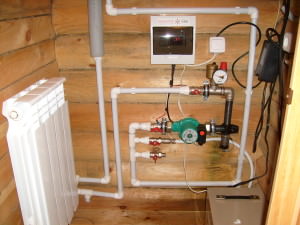 Electric boilers are also used in water heating systems. The principle of their operation is similar to gas boiler, but operates using electricity.
Electric boilers are also used in water heating systems. The principle of their operation is similar to gas boiler, but operates using electricity.
The advantages include:
If you have a wood stove and don't get a little primal, you can do what my older sisters used to do. Instead of running out into the outhouse in winter, my older brothers would eat a few sheets of newspaper and burn it in the wood stove.
Lack of power often contains no hot water or water at all
If you have a well pump, a power outage means no water without a backup generator. If you are connected to city water, you may or may not have water, depending on the area affected by the outage and whether the city has backup pumps. In any situation, there may be enough pressure in the water supply to fill a sink or two for laundry, but you must have emergency water storage.
- No chimney required And separate room.
- Installation requires minimal documentation and it doesn't take much time.
- Easy installation allows you to do without specialists.
Minuses:
- Beneficial for use in small spaces, since the high cost of high energy consumption.
Even if you have a gas or propane water heater, chances are you won't have hot water for very long without electricity. Most gas and propane water heaters have electric ignitions to light a fire to heat the water. water in the tank until it stays hot, and that's it.
Don't swim unless absolutely necessary. Getting wet is quick way get really cold. Keep some baby wipes on hand for waterless cleaning. If you still have running water, Protect faucets that are at risk of freezing by turning on pencil-sized water.
Pellet boilers
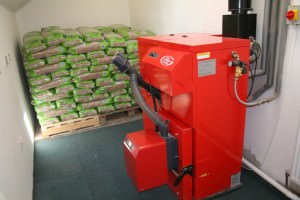 Pellet boilers are becoming popular for use in heating systems.
Pellet boilers are becoming popular for use in heating systems.
The meaning of their work is to obtain energy by burning special granules -. These granules are made from sawdust, straw, husks, by pressing under pressure.
Your car can be a refuge. If you have a serious cold, you can start the machine and use it for emergency heating for a short period of time. Carbon monoxide can be deadly. Have something to help pass the time that doesn't require power. Get a couple of decks of cards and card game or several books to print. Board games great too.
Large variations regionally and between house types
There are large regional differences in energy use as well as in the distribution of heat pumps. This reflects different composition housing stock. Despite the fact that Oslo is dominated by small apartment, Hedmark and many other areas of the country have a much higher proportion of large single-family homes.
There are also peat pellets. Boilers using this type of solid fuel have a specific design and are designated as pellet.
They consist of the following parts:
- Enclosures with automatic and leads to the heating circuit and chimney.
- Fireboxes with a heat exchanger and equipped with a chimney.
- Bunker for pellets.
- Mechanism, ensuring the supply of pellets to the burner.
- Burners for granules.
After the pellets enter the burner, they are ignited. This is usually achieved with a small and forced ventilation. The resulting heat from combustion of pellets heats the heat exchanger and the water in it. The water, in turn, begins to circulate through the heating system. Accordingly, such boilers are also used in water heating systems.
Detached homes are the most energy-intensive home type, with average energy consumption more than double that of apartment buildings. This is due to a larger living area, more external walls and, more often than not, more domestic members than in an apartment. Thus, it is more profitable to use the heat pump separately standing house than in a residential building.
Some energy savings with heat pumps
Homes with a heat pump use slightly less energy than similar homes without. heat pump. There is no big difference in energy consumption, but households with a heat pump use less wood and oil. Because air source heat pumps are powered by electricity, power consumption is not necessarily reduced unless the household was using electricity before purchasing the heat pump. Additionally, many people use a heat pump for cooling in the summer, which can increase energy consumption.
Principle of operation:
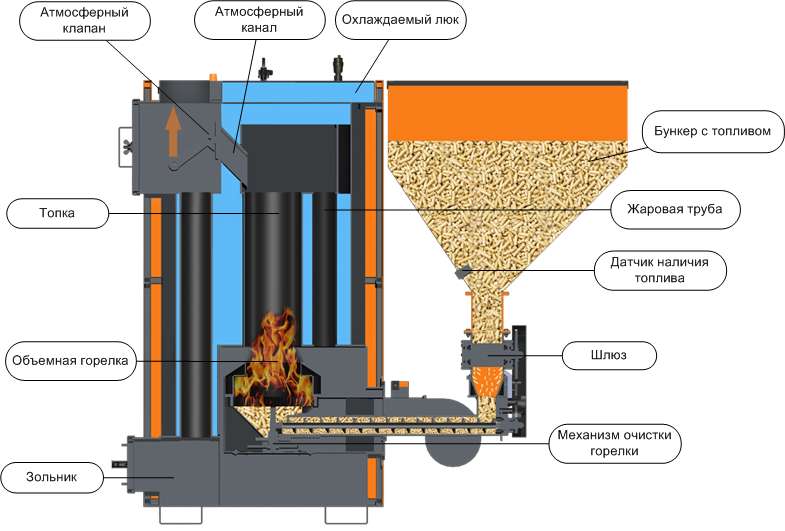
Principle of operation
The advantages of pellet boilers include:
- High automation capability heating systems. For example, using an electronic heating unit, you can set the selected operating mode for the desired period.
- Some types of pellet boilers are energy independent, which is their advantage and allows you to save energy.
- They do not require large premises for storing fuel.
- When burning pellets, virtually no ash or soot remains.
The disadvantages include:
Downward trend in energy consumption
Oil use dropped sharply to around 700 kWh.
More energy efficient buildings
One of the reasons for reducing energy consumption in last years is that there was a milder climate. During other years it was warmer than normal. According to the survey, 36 percent of households said they have taken steps to reduce energy consumption, and of those, about 80 percent said lowering energy costs was an important reason for their efforts. About 40 percent said they added more insulation to their homes, and 61 percent said they switched to windows that insulate better.- Often high cost pellet
- A chimney is required.
- Ensuring control the number of pellets in the bunker and adding them.
- Mandatory cleaning once a month.
- In addition, these boilers are floor standing and take up a lot of space.
Generally, water heating has a number of pros and cons. The advantages are - uniform heat distribution in relatively small rooms, the ability to limit the upper temperature limit.
Which Asian country has no permanent rivers?
In addition, new dwellings also have higher insulation requirements, which has contributed to a reduction in specific energy consumption. A small proportion also stated that they owned low energy or passive houses. Increasing heat pumps may also have some impact on leveling out household energy consumption.
Norway remains one of the few countries where the main source of heat is electricity. The main source of heat for approximately 73 percent of households is based on electricity, either electric heaters, electric underfloor heating, air-to-air heat pumps, or central heating with electricity. Twelve percent said their main source of heat was wood fuel. These are especially farm houses that use fuel wood.
An obvious disadvantage is the possibility of freezing water in the pipes and radiators of the heating system, which will inevitably lead to their damage after defrosting. High hydrostatic pressure and thermal inertia are also disadvantages.
Features of the operation of heat guns
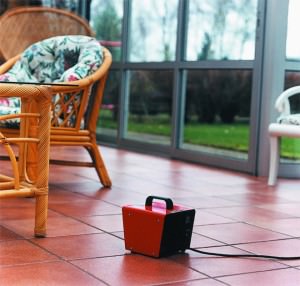 This heating method is effective in large rooms where there is no constant heating system. Often, heat guns used for heating industrial premises.
This heating method is effective in large rooms where there is no constant heating system. Often, heat guns used for heating industrial premises.
Inventions central heating and air conditioning, coupled with cheap and seemingly plentiful fossil fuels, would allow building designers to consider the outdoor environment and allow them to use brute force heating and cooling solutions to overcome building designs that are woefully inadequate for their local climate.
By the end of the 19th century, the invention of inexpensive cast iron radiators would bring central heating to American homes, with a coal boiler in the basement delivering hot water or steam into radiators in each room. Without electricity or fans to move air, these early furnaces transferred heat by natural convection through ducts from the basement furnace to the rooms above.
The operating principle of this equipment is heat exchange between heated air and a heat gun. The supply of warm air is provided using a fan installed in the device or due to natural convection.
Heat generation is achieved by burning fuel - gas, kerosene, waste oil or hydrocarbon fuel. There are also electric heat guns.
Shortly thereafter, gas and oil versions of forced air furnaces would allow homeowners to eliminate the hassle of "starting a coal fire" and remove coal furnaces and cast iron radiators into the dustbin of history. The cooling of homes in America follows another timeline closely related to the development of electricity as a means of delivering useful energy to our homes.
In contrast to the influence of the relative convenience of central heating, air conditioning will have a profound impact on both building design and population migration and development. Widespread use of air conditioning will eliminate front porches, wide eaves and high ceilings from the industrial building and enter into the ranch house, "picture" windows and sliding glass doors. Together, the inventions of central heating and air conditioning, coupled with cheap and seemingly plentiful fossil fuels, may allow building designers to consider the outdoor environment and allow them to use brute force heating and cooling solutions to overcome building designs that are completely out of sync with their local environment. climate.
Different methods of heat generation determine different models of heat guns.
Pros of heat guns:
- , allowing the device to automatically turn on when the temperature drops.
- Protection system does not allow overheating and will last a long time.
- The device is quite economical.
Minuses:
- Large dimensions diesel and gas heat guns.
- Not environmentally friendly some types of these devices.
These types of heating devices include fan heaters. The principle of their operation is similar to a heat gun, but they are more compact in size and are designed to work in small spaces.
These cities owe their existence to the invention and continue to use air conditioning. Before air conditioning, American life followed seasonal cycles determined by the weather. Worker productivity dropped in direct proportion to the heat and humidity outside—on the hottest days, employees left work early and businesses closed their doors. Shops and theaters are also closed, unable to comfortably accommodate large groups people in suffocating interiors. They cooled off by getting wet - by opening fire hydrants, going to the beach or diving into swimming holes. - National Construction Museum.
Heat generators
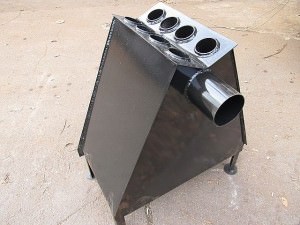
Heat generator "Bison"
The heat generator is a modified centrifugal pump. There are two types of heat generators - rotary and static. There are heat generators for air and water heating.
Fans and radiators for home heating
We would become a nation that spent more than 5% of our gasoline consumption just to keep the air conditioning in our cars running while we drove from our air conditioners to our air conditioned offices, factories, and shopping centers. Strengthening this way of life will become increasingly difficult in a climate-affected “post-pixel” of oil, gas, coal and uranium.
Installation costs
Microorganisms are the worst enemy of tattoos and piercings. They are sent to their own devices, and they take root from clients receiving tattoos and piercings, and can potentially cause them a variety of problems, from irritations to infections or worse. to ensure your workspace is properly sterilized at all times.
The principle of operation of a water heating heat generator is that the heated coolant is supplied by a pump to the heating devices. They release heat and lower the temperature of the coolant. Then, the coolant is returned back for subsequent heating. The coolant can be water or.
Generator air heating works on the principle of a heat gun, heating the air and releasing it through ventilation ducts. They are used mainly in industrial, agricultural and warehouse premises.
Depending on the type of fuel, there are diesel, gas and solid fuel heat generators.
The disadvantages of most heat generators are noise, large size and too much power for small rooms.
Stove heating
There are two types of stove heating:
Regular traditional

It is heating through the use of released energy, which is achieved during the combustion process. This stove has a classic appearance with firebox, chimney and ash collector. Such stoves heat only small rooms and take up a lot of space; they require constant addition of a combustion product (coal and wood), which are disadvantages.
Greater inertia, provision of a chimney and constant control of combustion can also be considered disadvantages. The advantages include: heating and cooking food using an oven, the possibility of constructing with my own hands, use in places where there is no gas or electricity and the function of some room decor.
Water heating
![]()
Achieved by connecting a heat exchanger with a water circuit to the firebox of the furnace connected to a water heating system. A distinctive advantage from the previous type is the heating of large rooms.
By functional features, stoves are divided into heating, heating-cooking and fireplace stoves. They come in metal and brick.
Fireplace as a type of heating
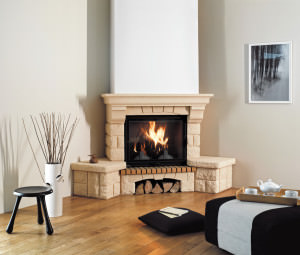 There are several types of fireplaces:
There are several types of fireplaces:
- Built-in– fully equipped in the wall.
- Wall mounted– most of them are hidden by an additionally constructed wall.
- Freestanding (island).Such fireplaces are usually placed in the center of the room.
According to the type of combustion part, fireplaces are divided into open and closed type. With one, two or three radiating surfaces. A cheaper option with one surface, and it also has higher heat transfer. A fireplace with three radiating surfaces is the most inefficient and expensive, but is considered more aesthetically pleasing and beautiful.
To achieve heating results with a fireplace, it must be built with two fireboxes, then the fireplace has the function of a stove.
The advantages of such heating include:
- Uniform and fast heating premises.
- Long-term heat retention.
- Decorative function.
Minuses:
- Take up a lot of space, especially island fireplaces.
- Device requires connection professional workers.
- Possibility of precipitation through the chimney pipe.
There are also those powered by electricity. Such fireplaces have several levels of heating, do not make noise, do not require a chimney, are a bright addition to the interior, but require a lot of energy consumption.
Results
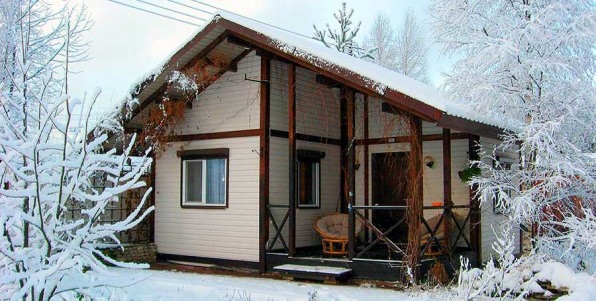
To summarize, it can be noted that gas-powered devices are the cheapest to operate. In second place in terms of cost are pellets. Coal and firewood are already more expensive fuels.
Electricity completes this list. When choosing equipment for heating a room, you need to weigh all factors, such as price policy, the possibility of self-installation, difficulty of use, availability of free space, etc. When the right approach you can create an alternative to other types of heating and get an economical and convenient heating system.
What is the living quarters for the crew on a ship called?
What is the name of the living space located under the roof of a building?

What is the name of the upper part of an industrial building converted into residential premises?

What can you improve?

Where can I meet?

Where or what can you sleep on?

What can be painted?

What can be protected?

What can you draw with?

What can you take?

What can you fan yourself with?

What can you dry?

What can you screw in?

What can you pray for?

What can be repainted?

What can be overclocked?

What can you slip on?

What can be done?

What can you pick?

What can you ride?
Random questions

Which American city has unofficial nicknames: “city of syrup”, “energy capital of the world”, “big heart”?

What do they do most often in the NBA?

Which of the following clubs larger number have you won the Champions League (Champions Cup) in football?

Who often hears the phrase: “Get out of here!”?

Who do all children love?

Which club was not the champion of Russia in football?

Which Asian country has no permanent rivers?

Which Soviet film does the cast correspond to: Andrei Mironov. Alexander Abdulov, Evgenia Simonova, Oleg Yankovsky, Evgeny Leonov?
100 to 1. How can you heat a living space (Vkontakte, Odnoklassniki)?
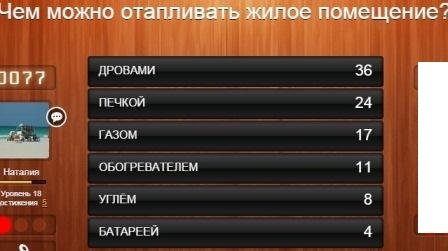
Firewood- And how do you picture it? A fire in the middle of the living room or bedroom -)
Stove- if the hut or Vacation home IR, then a good alternative to electric heaters. The warmth stays until the morning and everyone feels very comfortable and cozy at the same time -)
Gas- for those who like to burn “free9 Russian gas-), but it catastrophically consumes oxygen, making it impossible to breathe
Heater— oil is a priority because of its safety
Coal- this is for those who have point two - there is a stove in the house-)
Battery- Very modern solution, yesterday literally such a thing exploded in the office, now we’re sitting there freezing, waiting for it to be repaired
the system chose this answer as the best
Indeed, many ways to heat a room have been created today. The main thing is to have energy sources.
Firewood is the first answer, which will bring 36 points to the score. The old way Ideal for the stove.
Stove - answer option for 24 points, a general word, they did not decipher what kind of stove it was.
Gas - this answer will bring 17 points to the score. This is one of the most modern heating methods.
A heater is the answer for 11 points. Same great option, but it’s not economical.
Coal is also an option for a stove; it is a more economical fuel than wood. The answer will earn 8 points.
Battery - this answer will earn 4 points. The same option is offered in the game, which can represent various objects, and regular battery, so oil heater in the form of a battery.
Good luck on the next level of the game!
If you have a stove, you can heat it firewood .
Second answer stove- the main option. In any case, you need a stove - either individually or in a boiler room.
Gas. Gas heating - good option in case of natural gas availability.
Heater- if not central heating, you will have to get out either with stoves or heaters.
Coal- a logical option with a stove.
Battery- well, if the battery itself is made as a heater.
In this game "One Hundred to One" The correct answers are:
for answer "Firewood“—we get as many as 36 points,
for answer "Stove9- we will earn 24 points,
for answer "Gas9- we get 17 points,
for answer "Heater9- we get 11 points,
for answer "Coal"—we get 8 points,
for answer "Battery9- we get only 4 points.
Happy gaming everyone!
Which heating system to choose
Choosing a heating system for a house or apartment has great importance. After all, high-quality home heating provides not only warmth, but also comfortable conditions accommodation.

Stove heating
This is one of the ancient types of home heating, which is still popular today. The coolant in this system is circulating air.
The most popular are stoves with average thermal power; they are heated twice a day. Modern look The stove is equipped with fan heaters and air ducts, which help to increase the rate of heating of rooms and make it possible to heat rooms that do not have direct contact with the stove.
The heating efficiency depends on the area of interaction of the stove with the area of the room. How large sizes oven, the more efficiently it is heated.
Advantages of the furnace system:
- Economical. Its installation does not require large financial outlays or a lot of time.
- Use comparatively inexpensive type fuel.
- Autonomy. The stove can be built in any part of a residential building without requiring access to any communications.
- Connectivity to a water heating system.
The disadvantages include:
- Constant control while firing the stove. It is necessary to frequently check the operation of the stove and add fuel.
- The need for fuel reserves. It is necessary to constantly replenish the supply of firewood and coal, and also provide a place for their storage.
- Cleaning the oven. Quite often you have to clean not only the chimney, but also the rooms, since soot tends to penetrate into the home.
- High degree of fire occurrence or carbon monoxide poisoning.
- Volumetric dimensions of the structure. If the house is large, the design efficiency will be low: heating is uneven, and fuel consumption is quite high.

Fireplace: comfort and warmth
Fireplaces are not only a sophisticated piece of furniture, but high-quality installation fireplaces serve as an effective source of heat for any private home during the cold season.
Exists general scheme heating using fireplaces, which are integral part various designs:
- A fireplace built into the room warms the air in it.
- Hot air is directed through the pipeline and heats other living spaces.
This scheme makes it possible to significantly save the energy needed to warm up the home.
There are several heating methods using fireplaces:
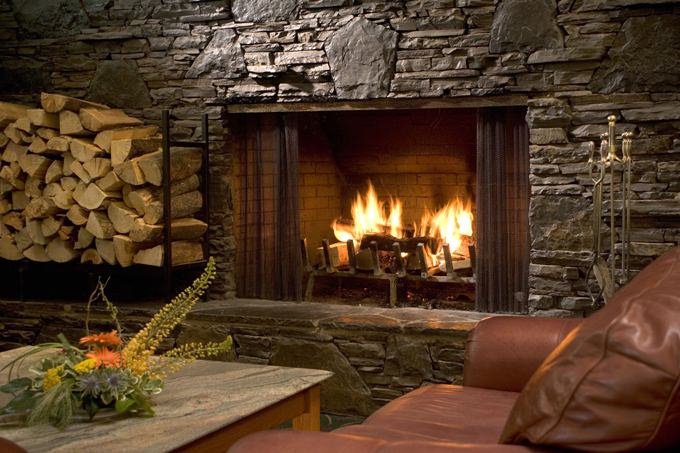
- With open camera. For stable heating of medium-sized and large areas its heat capacity is insufficient due to the low efficiency of the system (about 20%). The open chamber design consumes a large amount of fuel. In the room where the fireplace is installed, it is necessary to ensure high-quality ventilation to ensure the combustion process in open cells continuous air flow is required.
- Air heating. This method involves heating the air that passes between the camera body and its outer surface. Hot air is supplied throughout the room through an air duct. This method is autonomous from electricity, but it is advisable to use it to warm up no more than 2-3 rooms. To heat a house with a large area, it is recommended to use a forced movement of coolant. IN this diagram The heating system must include a pump, through which air is supplied under the chamber body or above the pump itself. Forced movement of the coolant makes it possible to effectively heat a private house quite large sizes.
- Water heated. A fireplace of this type has a built-in heating system, the coolant in which is water, which is one of the the best coolants and heat sources. The heat that was previously radiated by the walls of the chamber and went into the chimney pipe heats the water. Due to this, the room remains heated for a long time. As a result, the efficiency of the fireplace insert increases many times over. Hot water is supplied to the heat exchangers through a pipeline. A spiral-shaped radiator installed in the upper part of the structure, in addition to heating, allows you to heat water for domestic use. Manual control of the fireplace operation can be carried out by increasing or decreasing the flow of air mass into its chamber, and automatic control - through the operation of a device for maintaining a constant temperature (thermostat) with which the pumps are equipped. Temperature regulators automatically turn on the pumps after the coolant has warmed up to the desired temperature.
For space heating small sizes apply natural circulation coolant; for large rooms - forced, which allows you to distribute heat evenly.
The maximum area of all rooms of the house that can be heated with one fireplace ranges from 150-250 m2.
The advantages of fireplaces include:
- heating of a residential building is provided faster compared to water heating;
- no electrical connection required;
- the ability to control the combustion process;
- the ability to maintain and retain heat for a long time;
- profitability (due to the relatively low cost of firewood).
- a large supply of fuel material is required;
- regular cleaning of the fireplace;
- manual control of the heating process (it is necessary to periodically add fuel to the chamber).
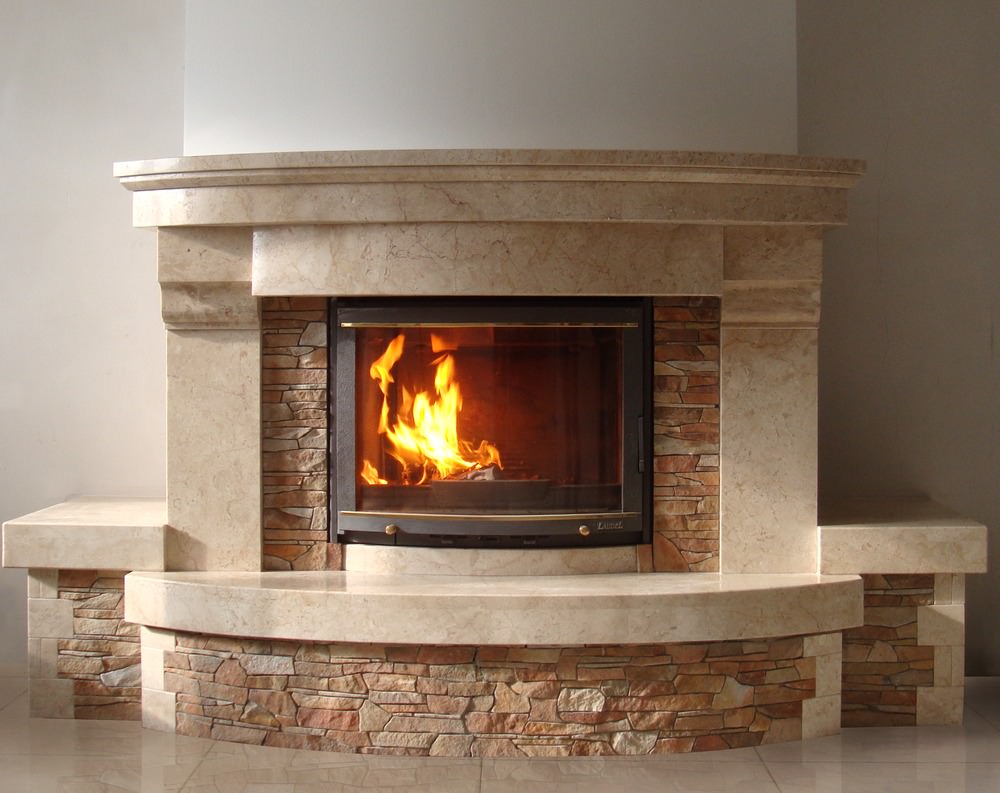
Boilers to choose from
This heating method involves the use of solid fuel, diesel fuel, and gas. The coolant is water, which moves through the pipeline and heat exchangers.
- Solid fuel.
- Liquid fuel.
- Gas.
- Electrical.
To ensure the operation of a solid fuel boiler, firewood, coal, peat, and coke are used. Heat generators operating on solid fuels are also produced - universal ones.
Modern boilers of this type can maintain a stable water temperature automatically. Temperature regulation is carried out by a sensor installed on the device and connected to the shutter. When a certain temperature rises, the damper closes and the combustion process stops; when the temperature drops, the damper opens.
The main advantages of this type heating devices is:
- possibility of creating autonomous system;
- solves the problem of heating a house in case of frequent interruptions associated with electricity or gas supply;
- affordable price of fuel resources;
- high degree fire safety(explosive substances are not used to ensure the operation of the boiler).
The disadvantages of the heating device include:
- the need to manually add fuel after a certain period of time;
- The installation should be cleaned several times a month;
- ensuring good ventilation;
- startup of the installation requires a long warm-up;
- slow heating.
Liquid fuel heating devices are used for country houses and large cottages. This is due to the fact that the combustion efficiency of liquid fuel is higher compared to solid fuel and natural gas. That is, with the correct ratio of dimensions, equipment using liquid fuel will be an order of magnitude more powerful than gas and solid fuel ones.
The fuel resource for heating the thermal mass is: fuel oil, diesel fuel, kerosene, waste oil.
Liquid fuel boilers are often installed in the absence of a gas pipeline, but if you plan to use natural gas in the future, it is worth installing boilers with the subsequent possibility of replacing fuel atomizers with gas burners.
The cost of the heating system of a liquid fuel heat generator is lower than an electric one, but much higher compared to a gas system.
The obvious advantages of boilers include:
- high power;
- allows you to heat large areas;
- small size of the unit;
- high efficiency;
- possibility of using different types of fuel.
- For installation of the boiler, a separate, well-ventilated room is required;
- high costs for the purchase and delivery of fuel;
- metal containers are needed to store fuel;
- V winter time fuel oil requires heating.
Today, gas heat generators are the most popular type of heating equipment, due to at an affordable price gas and the presence of gas mains. They come in wall and floor types.
Wall boilers are equipped expansion tank and pomp. They are divided into single- and double-circuit. Double-circuit systems provide space heating and water heating. Single-circuit devices only heat the thermal mass.
Floor-standing boilers require a separate room. They are divided into heat generators with inflatable and atmospheric burners. Devices with inflatable burners are characterized by ease of operation, efficiency, and low noise. Boilers with atmospheric burners are characterized by high efficiency and high cost.
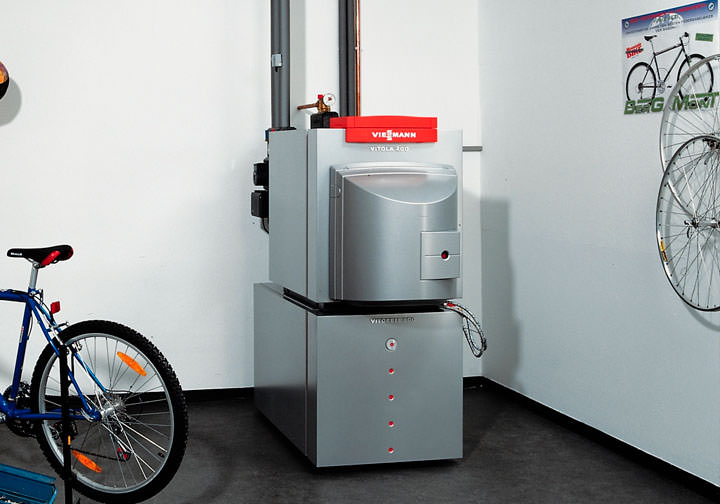
- efficiency;
- automatic operation process (in case of extinguishing the flame, the system ignites the burner);
- Suitable for heating large areas.
- installation of gas equipment requires approval from the relevant authorities;
- chimney installation is required;
- high degree of explosive situation;
- the need to install automation to prevent gas leaks.
The operating feature of an electric heat generator is identical to the operating principle of the above types of boilers. To ensure the heating process, an electric current is used to heat a tubular electric heating element.
The main difference between electrical units is the built-in device that supports constant temperature and temperature programmer. Thanks to this, you can adjust the power level and change the temperature in the house.
In case of frequent power outages, the use of electric boilers is not practical. Heating a large house is not economically profitable; this is due to the need to consume large amounts of energy resources.
Advantages of using electric heating:
- no permission or approval is required to install the unit;
- silent operation of the equipment due to the absence of a fan and pump;
- simple installation of the boiler and its operation;
- environmentally friendly due to the absence of toxic emissions.
- high power consumption;
- during power outages (which happens quite often), the residential building is not heated;
- high cost of heating in winter;
- requires high-quality electrical wiring (taking into account the power of the equipment and the use of electricity for domestic needs);
- It takes some time to heat the house; boilers do not heat up very quickly.
Modern technologies in action
Many owners of apartments and private houses are interested in modern technologies heating, which allows you to provide comfortable living conditions in your home. Let's note some of them:
Infrared heaters
Infrared devices are safe for humans and the environment; they do not emit harmful substances. The heat source is an emitter and a reflector, which direct heat rays in a given direction.
Thus, it is not the air in the room that is heated, but the space or objects at which the device is directed. The operating efficiency of this system is 5-15 m2 depending on the power of the installation.
- energy efficiency;
- resistance to mechanical damage;
- does not dry out the air in the room;
- noiselessness.
- high degree of fire hazard;
- high price.
Heating using a biofireplace, despite the fact that it emits a fairly large amount of heat, is not advisable to use for an autonomous home heating system.
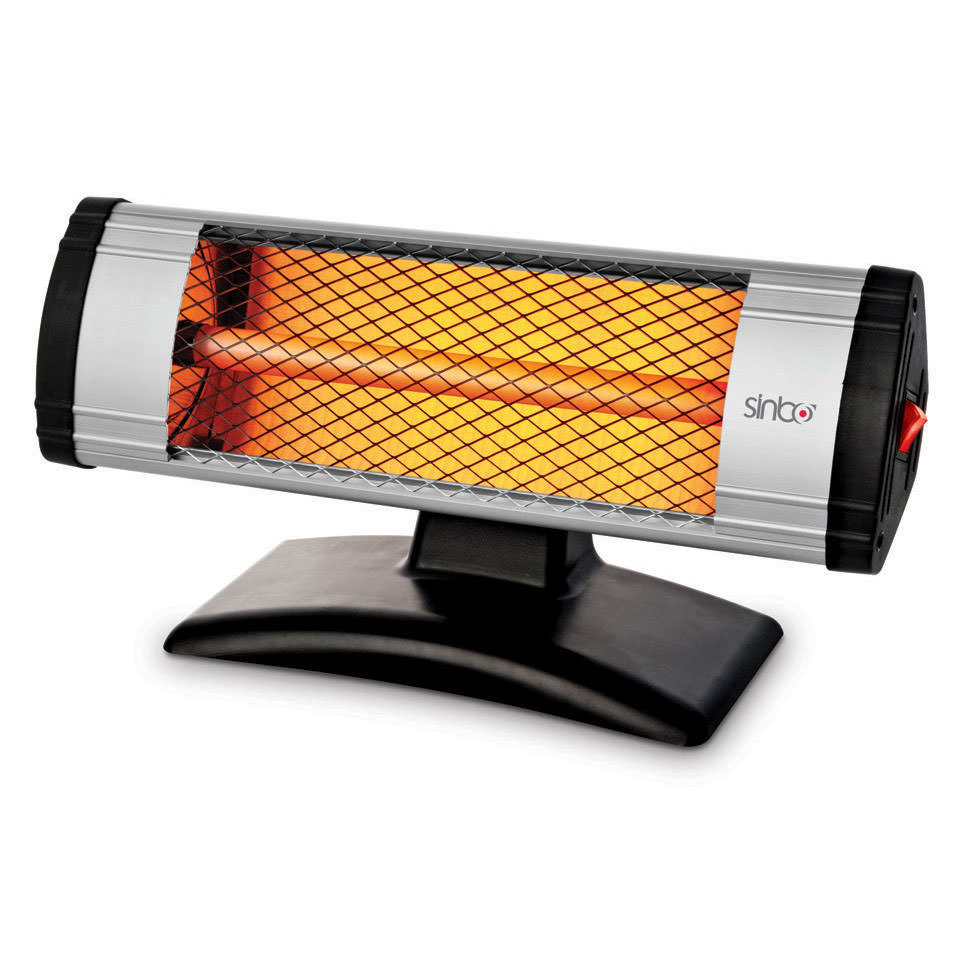
The biofireplace runs on biofuel – ethyl alcohol denatured alcohol. One device has the same power as an electric heater with a power of 4 kW. Installation of the device does not require a chimney or ventilation, so more than 90% of the generated warm air remains in the room.
- ease of installation and equipment management;
- does not require special permissions for installation;
- mobility.
- large monetary costs for purchasing fuel;
- high fuel consumption during intensive use;
- does not replace the heating system, but can serve as its supplement.

Heat guns
Heating using heat guns is most effective for heating large areas. The operation process is carried out due to the powerful blowing of air by a fan through the heating element, followed by the distribution of heated air throughout the room.
A device equipped with a thermostat. allows you to automatically turn off the device after dialing set temperature in a living room and turn on when it drops below a certain level.
There are several types of heat guns: electric, gas, diesel.
- high degree of efficiency;
- Suitable for homes without a heating system.
- high energy consumption;
- burn oxygen;
- constant need for fuel.
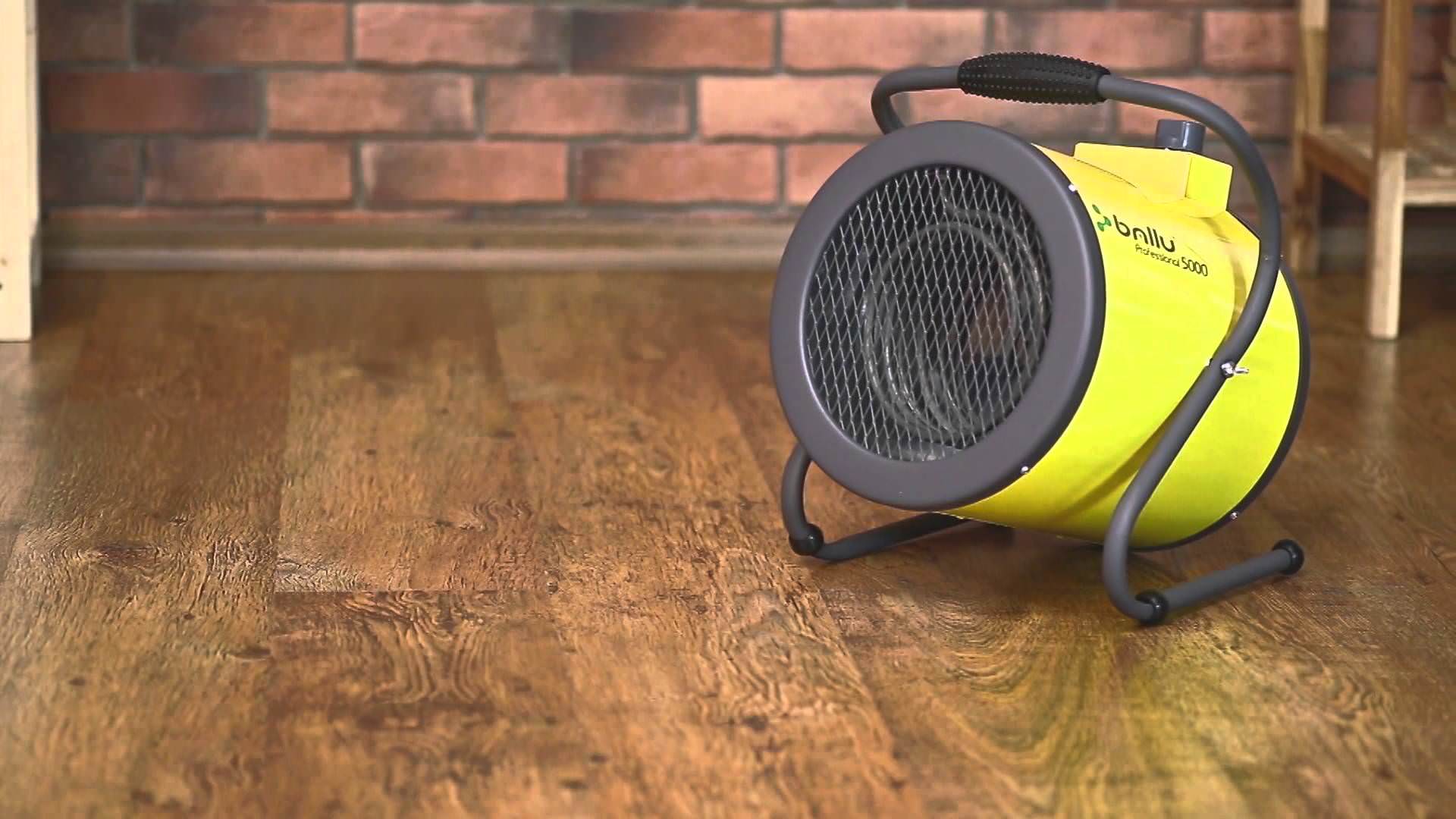
Electric convectors
For heating with electric convectors, a metal heating device is used as a working element, which is located inside the convector body. The heated air leaving the device is directed upward and, circulating throughout the room, heats it.
A thermostat is mounted inside the electric convector to maintain the required temperature. Correctly calculated power and number of devices are the key to quickly warming up the room.
- can be installed anywhere;
- ease of operation;
- do not dry the air;
- can be used in rooms with high humidity.
- low power;
- The wiring must withstand the total power of all devices.
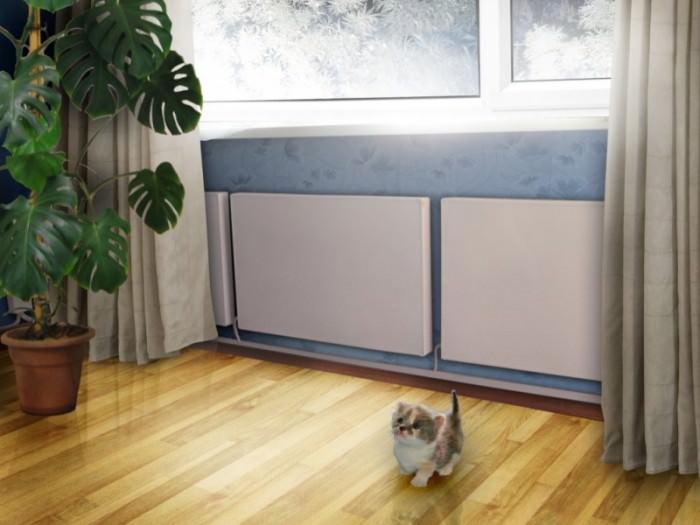
Solar panels
Heating a home with solar heating involves the use of solar collectors or panels. The panels are gradually falling out of widespread use due to the fact that the efficiency of collectors is an order of magnitude higher.
Collectors powered by solar energy, consist of tubes that collect heat. These tubes are connected to a reservoir that contains the thermal mass.
- environmentally friendly;
- ability to regulate temperature;
- long service life;
- does not require the use of electricity or gas;
- does not require restocking.
- requires a lot of space for installation;
- high price;
- decreased efficiency during bad weather;
- require constant cleaning of snow, dirt and deposits, otherwise the efficiency of the system is sharply reduced.

How to choose
When choosing a heating system, you need to decide how the home will be heated - throughout the year or periodically. For example, if a country house requires heating at certain times of the year, an electric convector, a small stove or a fireplace is sufficient for this. It is better to heat a house that is constantly used with water, gas or electric heating.
The next determining factor is the type of fuel that is most profitable to use for a given region.
The main indicator when choosing a heating system is installation and operating costs, namely:
- Price of fuel resources and heat generator.
- Cost of installation work.
- Repair, maintenance and preventative maintenance costs.
- Using a pump in a heating circuit with an electrode heater increases system efficiency up to 20%.
- To connect an electric boiler, a separate line is required from input distribution devices with subsequent grounding.
- For installation of electric boilers with a power of more than 10 kW permission from energy supervision services is required.
- Heating a large room with one heater will not be effective. therefore, several such devices should be installed simultaneously.
- It is not recommended to install heating devices near windows.
- Solar collectors usually serve as an auxiliary heating system, since they do not raise the temperature in the house to the optimal level in winter. Solar heating can be used as a primary system in regions where the sun shines at least 180 days a year.

Gas boiler for heating a private house - popular models

Hot water boiler: tips for choosing
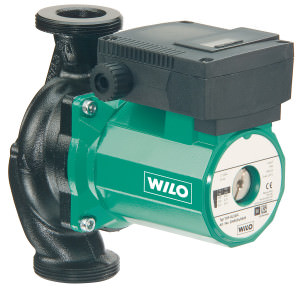
Circulation pump for heating - how to choose
Tip 1: 5 most efficient home heating devices
Convector, infrared rays and climate control
Fifth place rightfully belongs to convector heaters, the heating element of which is metal pipe with hot air. There are holes made in their bodies through which cold air enters the heater, is heated and released from the top of the heaters. Typically, a convection heater is installed on a wall or floor.
The convector has characteristics similar to those of oil radiators, but at the same time it also maintains the set temperature.
In fourth place are infrared heaters, which heat the room due to a lamp emitting infrared rays. They allow you to heat both individual zones and large rooms, and can also be used outdoors. The disadvantage is the high price of the device.
Third place in the ranking is occupied by air conditioners, which cool and heat the air with equal efficiency. They quickly warm up the air, automatically maintain the programmed temperature and do not require additional household appliances. However, air conditioners are not recommended for use at very low subzero temperatures.
Fans and radiators for home heating
In second place is the fan heater, which has mobility, simplicity of design and low price. Its body contains a ceramic or metal heating element, behind which the fan blades are installed. They create streams of hot air, dispersing them throughout the room and heating it. The main advantage of a fan heater is its combination of two functions – cooling and heating. Disadvantages of fan heaters include their noise, their burning of oxygen, and the risk of fire if safety standards are not followed. In addition, the fan blades are dangerous for small children.
Heat fans with ceramic element, which have high heat transfer.
Oil radiators take first place and are a sealed metal case containing mineral oil inside. It heats up and heats the radiator housing, as a result of which the warm air from it rises up and heats the room. This type of heater is silent, fireproof, does not burn oxygen and is quite inexpensive. Oil radiators are quite mobile due to wheels, and the degree of their efficiency depends on the number of sections in the heater body.
A chimneyless boiler is a heating device that does not require a chimney or draft to operate. Air intake and exhaust gases are removed through special device– coaxial pipe.
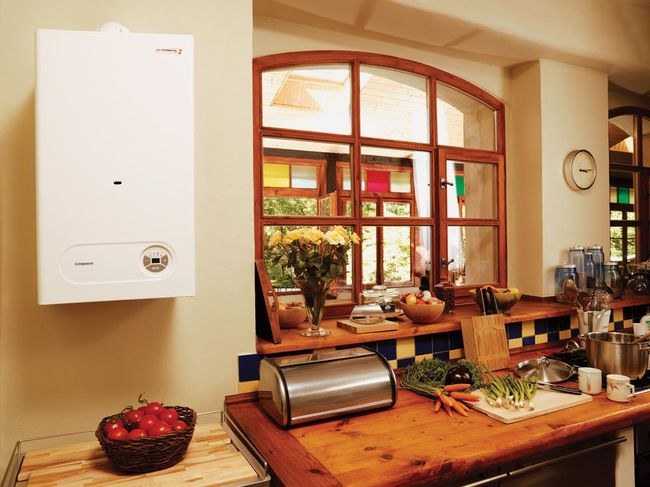
Chimneyless gas boilers are an excellent solution in cases where it is necessary to install a heating device in small room. They will also help you get out of a situation where it is impossible to equip your home with a stationary chimney. This heating system has a special smoke removal design, the main advantage of which is its compactness and location. It is located directly above the device.
Equipment design
Chimneyless boilers are designed to perform the same function as conventional ones. They are capable of heating a room and preparing hot water, but their combustion chamber is designed somewhat differently and there are differences in the operating principle. If a conventional gas apparatus operates through a chimney and draft, then this model takes in air and exhausts exhaust gases through a coaxial pipe. Equipment of this type can be connected to the system on one or both sides. At the same time, on the inside coaxial pipe gases are released, and outdoor system takes air into the boiler.
The design of chimneyless gas boilers is very convenient to use, and it is also fireproof. The high temperature of combustion products is extinguished by cold air coming from the street. Another advantage is that the boiler does not require draft and air flow - all these operations are performed forcibly due to the fan built into the equipment.
Types of boilers
Chimneyless boilers can be wall-mounted or floor-mounted. Wall-mounted, single-circuit, chimneyless gas boilers are recognized as the most effective. This model performs its main function not only by burning gas, but also by using the residual heat of condensate obtained from the vapor of air exhausted into the atmosphere. Particularly high results can be achieved at low-temperature operating conditions, in particular, if a certain section of the heating system is designed according to the principle of heated floors. Since the temperature of the coolant in the “warm floors” system is only 45-50 ° C, this allows water vapor to condense more strongly in the exhaust gases.
Condensing units have the highest efficiency, environmental friendliness and minimum consumption fuel. The disadvantage of such equipment is the need for special removal of condensate generated during operation. Such moisture cannot be drained into surface water or soil, as it is saturated with acids and can disrupt the bacterial microflora. For a wall-mounted condensing boiler, the chimney should be made only of high-quality plastic that is resistant to acid vapors.
How to heat a house if there is no gas: comparison of heat sources according to 3 parameters
This article is about how to heat a house if there is no gas. In it I'm going to talk about possible alternatives gas heating, evaluate them in a series key parameters and offer the reader the most profitable and practical solutions. Let's get started.

Gas is the cheapest source of heat. But it’s not available everywhere.
Can you see everyone?
Here full list Possible heat sources for a home without gas:
- Solid fuel (wood, coal, pellets);
- Liquid fuel (diesel fuel, used motor oil);
- Electricity;
- Solar heat recovered through solar collectors;
- Liquefied gas (from a gas tank or cylinders). If your locality is not supplied with main natural gas, this does not mean that you cannot use a gas boiler or convector for heating.
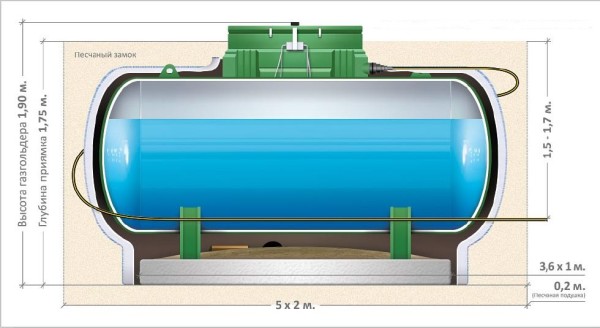
The gas tank will provide autonomous gas supply where there is no main line.
What we evaluate
By what parameters do we compare possible solutions?
- Minimum operating costs (that is, the cost of a kilowatt-hour of thermal energy);
- Cost of equipment;
- Ease of use of the home heating system. It should require as little attention as possible from the owner and work offline for as long as possible.

An ideal boiler does not require the owner's attention.
Operating costs
Here's how our participants line up when assessing their cost-effectiveness:
- The undisputed leader is solar heat. Collectors convert it into heating coolant completely free of charge. Electricity is consumed only by circulation pumps;
Usually, solar collectors are used only as an auxiliary heat source. Their problem is fickleness. thermal power: It varies depending on the length of daylight and the weather.
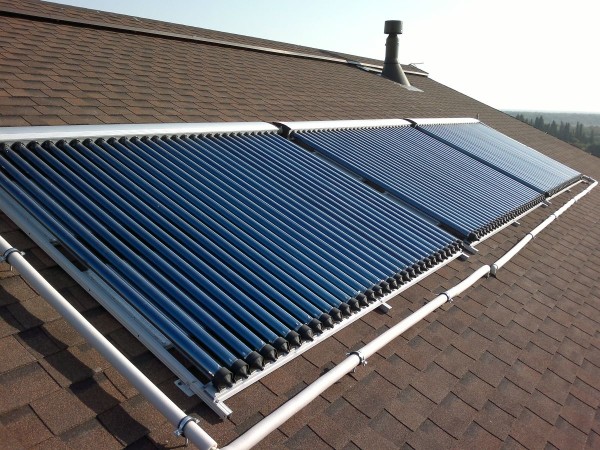
Pitched roof with solar collectors.
- In second place is a solid fuel boiler that runs on wood. Yes, yes, I am aware that we are in the 21st century. That's how it is Russian realities: in the absence of main gas and with short daylight hours, firewood is still more economical than all other heat sources and provides a cost per kilowatt hour of 0.9 - 1.1 rubles;
- Third place is shared by pellets and coal. Depending on local energy prices, a kilowatt-hour of heat obtained by burning them will cost 1.4-1.6 rubles;
- Liquefied gas from a gas tank provides a kilowatt-hour cost of 2.3 rubles;
- The use of cylinders increases it to 2.8 - 3 rubles;
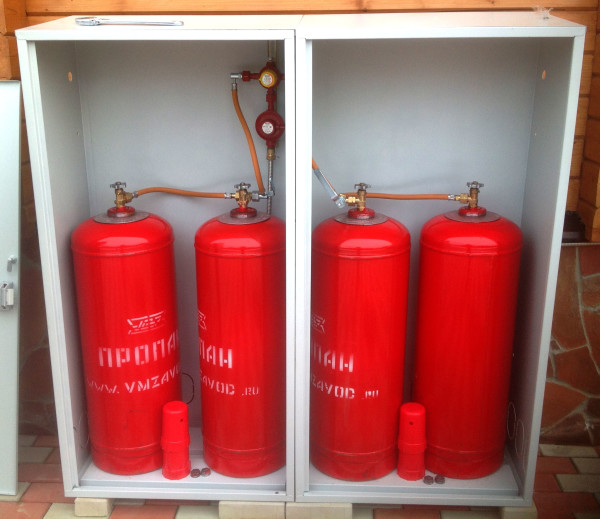
The gas cylinder station will allow you not to change the cylinder every day.
- Liquid fuel boilers running on diesel fuel produce heat with an average cost of about 3.2 rubles/kWh;
Used motor oil with the same calorific value costs 5-6 times less. If you have a constant source of waste, this type of fuel can successfully compete with main gas.
- Clear outsiders - electric boilers. The price of a kilowatt-hour of heat obtained by heating water with a heating element or any other direct heating device is equal to the cost of a kilowatt-hour of electricity and, at current rates, is approximately 4 rubles.
Let me emphasize: the so-called economical electric boilers(induction or electrode) is a fiction. They, of course, work, but the method of heating the water does not in any way affect the cost of a kilowatt-hour of thermal energy.
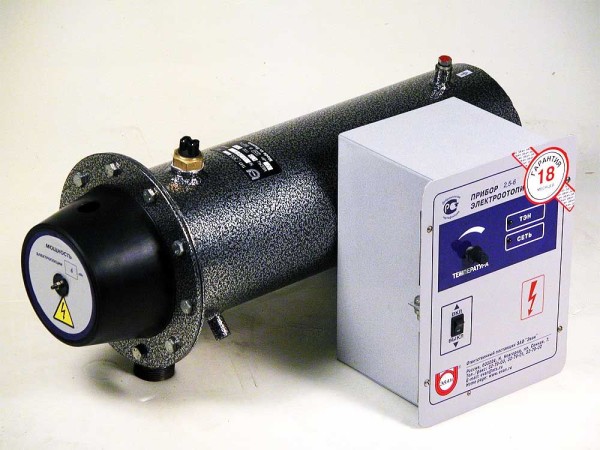
Induction electric boiler. Its undoubted advantage is reliability. But in terms of efficiency, it is no different from a device with heating elements.
Installation costs
How much will it cost to install heating in a country house or country house?
In order not to cause confusion due to the variation in the parameters of the heating system, I will compare the average cost of heat sources of the same rated power - 15 kW.
- Gas boiler - from 25 thousand rubles;
Without a gas main, the owner will have to invest in the equipment of a gas station or gas holder, which will increase costs by another 150 - 250 thousand.
- Pellet boiler - from 110,000;
- Electric boiler - from 7000;
- Solid fuel boiler - 20,000;
- Liquid fuel (diesel or exhaust) - from 30,000;
- Solar collectors with a total power of 45 kW (threefold power reserve compensates for downtime dark time days) - from 700,000 rubles.
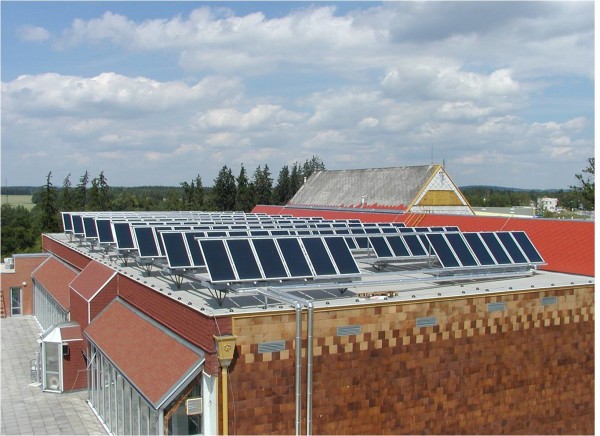
Downtime at night has to be compensated for by the number of collectors.
It is obvious that a reasonable balance between the cost of a kilowatt-hour of heat and the heating equipment provide only firewood and coal. A good alternative to them - used oil - cannot participate on equal terms in our competition due to the inaccessibility of this energy carrier.
Free solar heat turns out to be prohibitively expensive at the installation stage: the cost of a thermal energy accumulator will be added to the exorbitant costs of the collectors themselves.
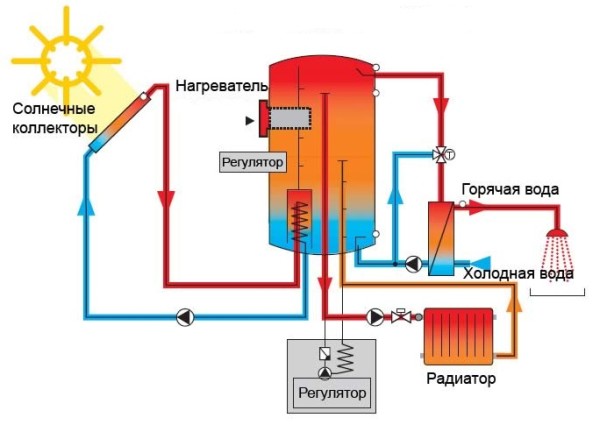
Diagram of a heating system with solar collectors.
Ease of use
Laziness, as you know, is the engine of progress. You want to heat your home not only cheaply, but also with minimal costs time and effort.
What do you have different options heating with autonomy?
- Electric boilers are in the lead. They work indefinitely and do not require any maintenance at all. The coolant temperature can be adjusted automatically using a remote electronic thermostat. Electrical equipment allows you to program daily and weekly cycles (for example, reduce the temperature while you are away);
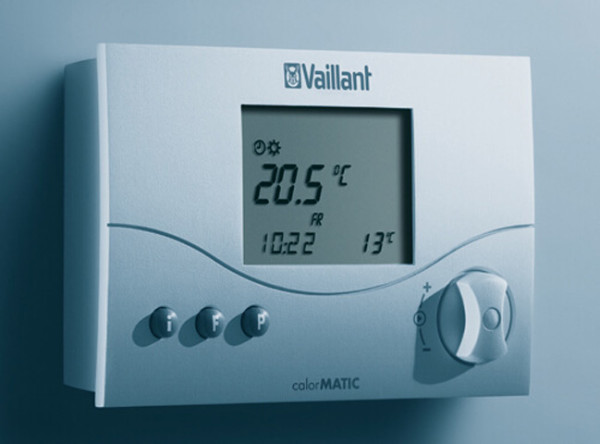
Remote thermostat for an electric boiler.
- Gas boiler with gas holder provides autonomy for several months, or even an entire season. It differs unfavorably from an electric boiler in the need to remove combustion products, so the location of the device is tied to the ventilation, chimney or external walls private house;
- Autonomy liquid fuel appliance limited only by the volume of the fuel tank;
A separate room must be allocated for a diesel boiler. The reasons are the high noise level when the burner is operating and the smell of diesel fuel.
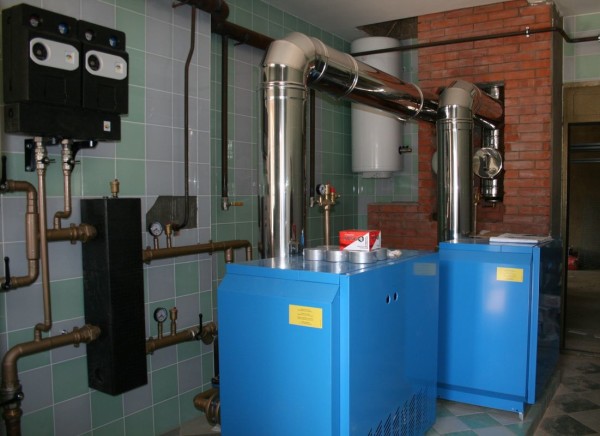
- The use of several parallel-connected cylinders reduces the autonomy of heating equipment by up to a week;
- A pellet boiler can work approximately the same amount of time on one load;
- Solid fuel boiler needs to be refilled every few hours and periodic cleaning of the ash pan. This period can be increased by limiting the thermal power with a covered air damper, but in this case, incomplete combustion of the fuel will reduce the efficiency of the device and, accordingly, increase the owner’s heating costs.
What's the result? But in the end, comrades, we have to choose between the limited autonomy of a pellet boiler with its rather high cost, the continuous kindling of a solid fuel appliance and the sky-high cost of thermal energy from an electric boiler.

the main problem solid fuel heating- frequent kindling.
How can you heat a living space, combining acceptable equipment autonomy with low operating costs?
We can go one of two ways:
- Try to increase the autonomy of the system with solid fuel boiler;
- Minimize electric heating costs.
Now - in more detail about each possible solution.
Pyrolysis boiler

Construction of a pyrolysis boiler.
This is the name of a type of solid fuel device that splits the combustion process of coal or wood into two stages:
- Smoldering with limited air access (so-called pyrolysis). Incomplete combustion of fuel results in the formation of a flammable mixture of volatile hydrocarbons and carbon monoxide CO;
- Afterburning of pyrolysis products in a separate firebox. It is usually located under the main one and ensures its heating to the temperature required for pyrolysis.
What does such a scheme provide?
- Flexible power adjustment by simply changing the speed of the supercharged fan;
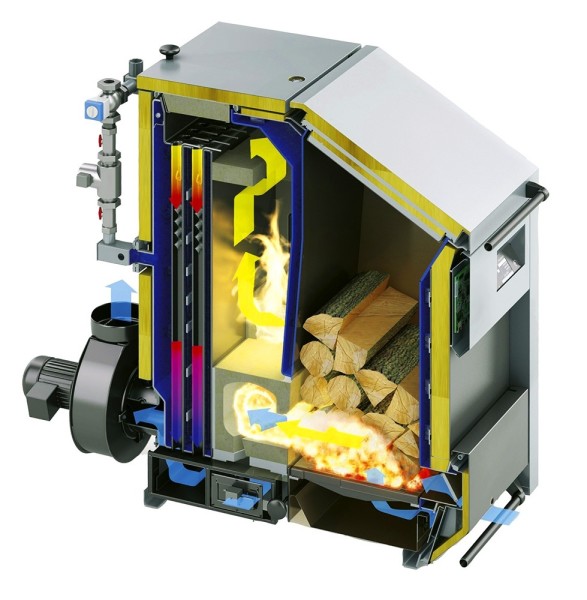
By changing the speed of the forced-air fan, you can regulate the thermal power of the boiler.
- Maximum efficiency over the entire range of power values (since the products of incomplete combustion of fuel are burned in the second combustion chamber);
- Autonomy 10-12 hours. It is achieved precisely by limiting the combustion rate of solid fuel.
Top combustion boiler
Another step towards increasing the autonomy of solid fuel heating equipment was taken by engineers of the Lithuanian company Stropuva. They just transferred the process of smoldering fuel from the grate to the upper part of the firebox. As a result, as the filling volume increases, it is not the thermal power of the boiler that increases, but the combustion duration.
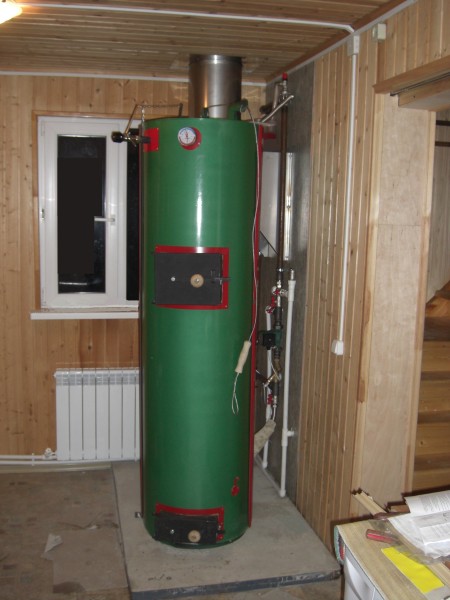
Boiler room with solid fuel top burning boiler.
How was this result achieved?
The boiler is a vertical cylinder with a telescopic air duct ending in a massive steel disk with fins (called staskoblin). As the fuel load burns out, the air duct lowers down under its own weight, at every moment providing air supply directly to the area of smoldering fuel.
The same disk separates the smoldering region of the fuel and the afterburning region of incomplete combustion products, turning the upper combustion boiler into a type of pyrolysis boiler. A small amount of ash remaining on the surface of the firewood is carried away by the rising flow of hot gases.

Design and main elements of the device.
Maximum autonomy was demonstrated by the Stropuva boiler running on coal. He worked on one tab for 31 hours.
Thermal accumulator
Is it possible to heat a country house with an ordinary solid fuel boiler without spending a significant part of the day on kindling and cleaning it?
Yes. A heat accumulator will help with this - a regular water tank with thermal insulation and several outlets for connection heating circuits. Water has a fairly high heat capacity. Thus, a tank with a volume of 3 m3, when the coolant is heated by 40 degrees, accumulates 175 kWh of heat, which is enough to heat a house of about 80 m2 during the day.
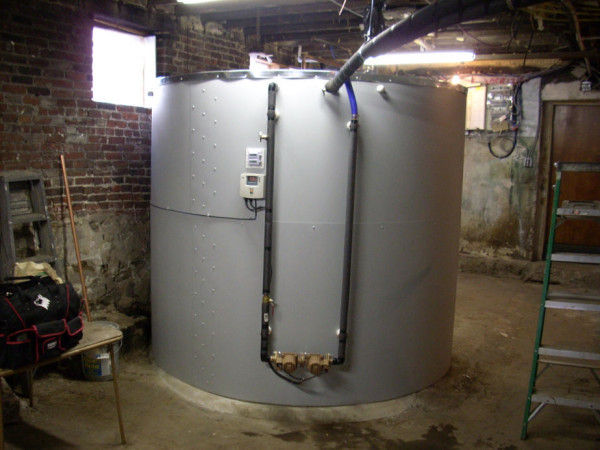
How to install a heating system with a heat accumulator with your own hands?
It forms two circuits with forced circulation:
- The first connects the boiler heat exchanger to the battery;
- The second combines a heat accumulator with heating devices - radiators, convectors or registers.
- The boiler is heated once or twice a day and operates with the damper fully open, at rated power (and, accordingly, with maximum efficiency);
- The rest of the time, the heat accumulator gradually releases the accumulated heat to the house.
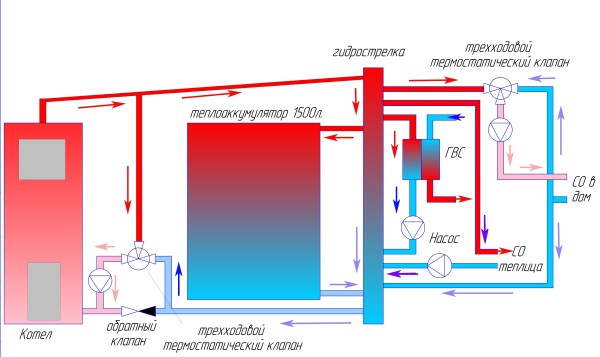
Heating circuit with heat accumulator.
This scheme will also help to heat the house at minimal cost to owners of electric boilers, but only if they have a two-tariff meter. At night, during the minimum tariff, the boiler heats water in the tank, and during the day the accumulated heat is gradually released by radiators.
Warm floor
Underfloor heating systems transform the entire surface of the finished flooring into the heating device.
For heating can be used:
- Pipe with coolant laid in a screed;
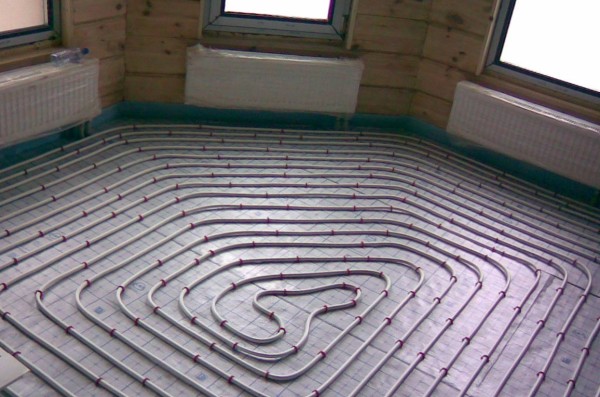
Laying pipes for water heated floors.
- Heating cable laid in a screed or in a layer of tile adhesive under the tiles;
- Film heater - polymer film with those with high electrical resistance current-carrying paths. The heater is placed under a finishing coating of sufficient thermal conductivity - laminate, parquet or linoleum.
Warm floors can reduce heating costs by 30-40% compared to convection devices - radiators or convectors. Savings are achieved through temperature redistribution: the air is heated to a maximum of 22 - 25 degrees at floor level, while the temperature under the ceiling is minimal.

Air temperature for underfloor heating.
With convection heating, for a minimum comfortable +20 at floor level, the air under the ceiling will have to be heated to 26 - 30 degrees. Heating only affects heat leakage through the ceiling and walls: they are directly proportional to the temperature difference on both sides of the building envelope.
I used film heaters to heat the floors under my desks. With ridiculous electricity consumption (on average 50-70 watts per square meter) they provide subjective comfort during work even at a room temperature of 14 - 16 degrees.
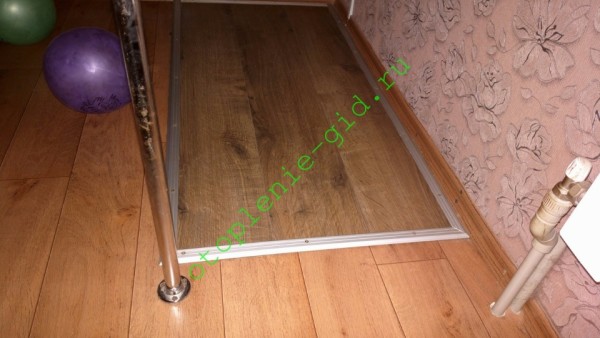
A strip of film heater is laid under the laminate under the work table.
Infrared heaters
Traditional heating heats the air in direct contact with heating device. However, with a relatively small area heating element and him high temperature Another method of heat transfer begins to predominate - infrared radiation. This is what infrared heaters use, positioned as devices for economical heating with electricity.
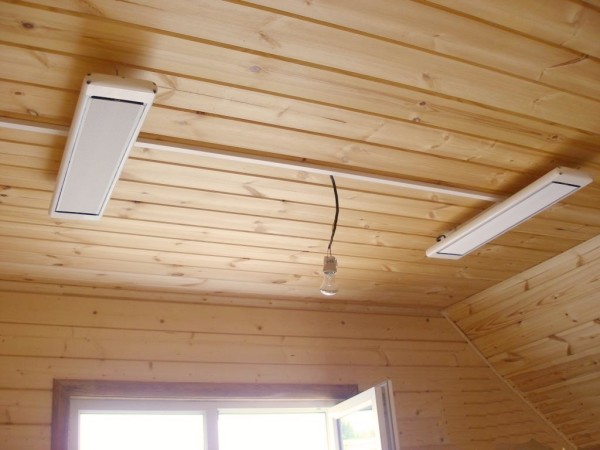
Ceiling infrared panels.
How infrared heating better than convection?
Placed under the flow or on the wall, the device warms the floor and all objects in the lower part of the room with radiant heat. The effect is approximately the same as when using a heated floor - below the air temperature is made maximum, under the ceiling - minimum.
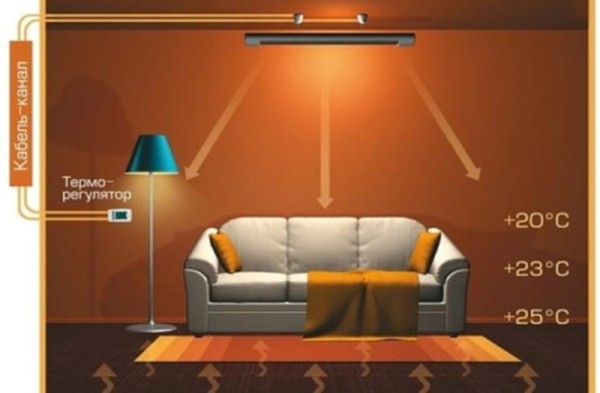
Air heating with infrared heating.
Moreover, radiant heat warms the skin and clothes of people in the room. It creates a subjective feeling of warmth, allowing you to reduce the comfortable temperature in the room from 20-22 to 14-16 degrees. We have already found out how the temperature difference with the street affects heating costs.
At -10 outside the window, reducing the average temperature in the room from 25 to 15 degrees will reduce heat consumption by (25 - -10)/(15 - -10) = 1.4 times.
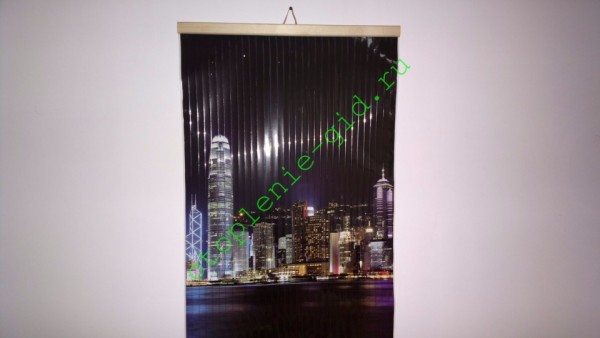
Film infrared heater power 400 watts.
Heat pumps
What is a heat pump?
Structurally, it is identical... to a regular refrigerator. The design of this device allows you to take heat from a colder environment (ground, water or air) and release it more quickly. warm air inside the house.
How is this achieved?
This is what the operating cycle of any heat pump looks like.
- A compressor compresses a refrigerant gas (usually freon), turning it from a gas to a liquid. In full accordance with the laws of physics, it heats up;
- Freon passes through a heat exchanger where it gives off heat;
- Next on the path of the refrigerant is the expansion valve. With a sharp increase in volume, freon returns to a gaseous state and cools sharply;
- Passing through another heat exchanger, it takes heat from the environment that is warm compared to the cooled freon;
- The heated refrigerant is returned to the compressor for a new cycle.

Schematic diagram of a heat pump.
As a result, electricity is spent only on the operation of the compressor, and for every kilowatt of its electrical power, the owner receives 3-6 kilowatts of thermal power. The cost of a kilowatt-hour of heat is reduced to 0.8 - 1.3 rubles.
Moreover, all types of heat pumps fully possess the advantages of electric heating devices:
- They do not require maintenance or removal of combustion products;
- They can be programmed for daily and weekly cycles, further reducing heat consumption.
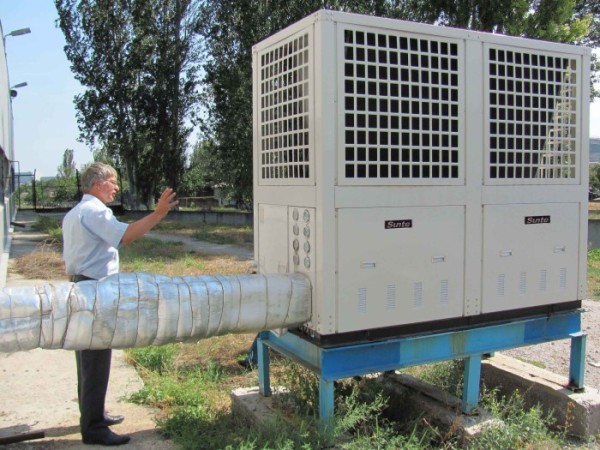
External air source heat pump unit.
It is useful for a potential heat pump buyer to know several things about these devices:
- The warmer the low-potential source of thermal energy, the higher the COP of the device (coefficient of performance, the number of kilowatts of heat per kilowatt of electrical power when operating for heating);
- COP also increases when the temperature of the internal (located in the house) heat exchanger decreases. That is why low-temperature heating is usually used with heat pumps - heated floors or convection devices with an increased fin area;
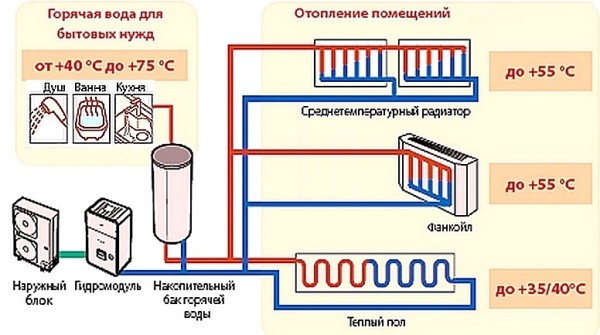
Low temperature heating with heat pump.
- The lower temperature of the external heat exchanger is limited by the freon phase transition temperature and cannot be lower than -25 degrees. That is why heat pumps operating according to the “air-to-water” and “air-to-air” circuits can be used for heating only in the southern regions of the country;
- The Achilles heel of geothermal and water pumps is the high cost of installing external heat exchangers. Vertical soil collectors are immersed in wells several tens of meters deep, horizontal ones are placed in pits or trenches, and their total area is approximately three times the heated area of the house.
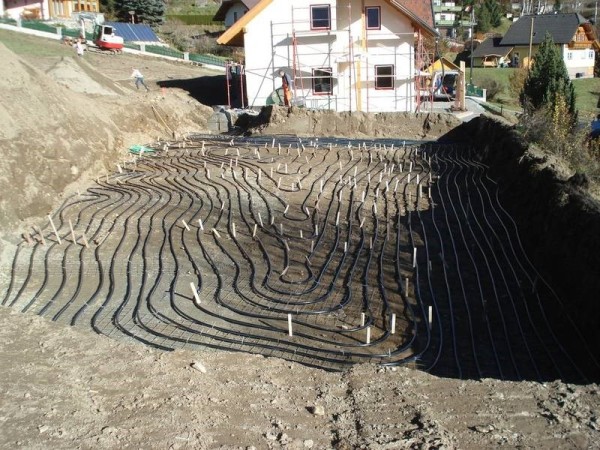
Laying a horizontal heat exchanger for a geothermal pump.
A water heat exchanger requires a non-freezing reservoir or well with sufficient flow. In the latter case, the manufacturer’s instructions require that waste water be drained into another well—a drainage well.
A special case of a heat pump is a conventional air conditioner. In heating mode, it uses heat collected from the outside air by an external heat exchanger. The COP of a modern inverter split system reaches 4.2 - 5.
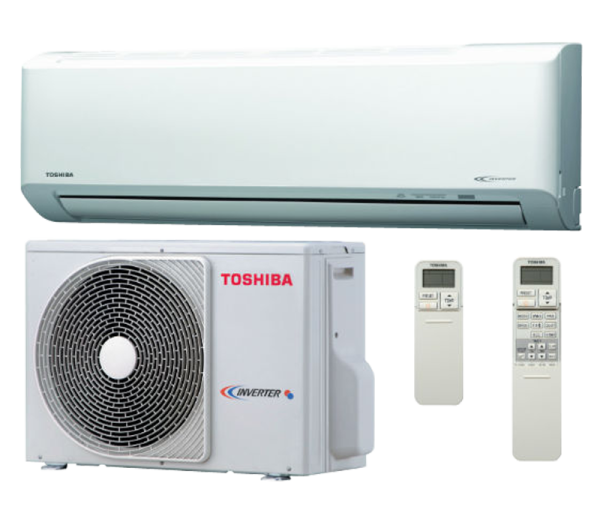
The most affordable heat pump.
The main source of heat in my house is split systems installed in each room. How profitable is it to heat a house with air conditioners and how expensive will their purchase and installation cost?
Here's a short report:
- Two floors with a total area of 154 m2 are heated by four inverter air conditioners - three with a capacity of 9000 BTU and one with a capacity of 12000 BTU;
- The cost of one air conditioner at the time of purchase ranged from 20 to 25 thousand rubles, depending on the model and manufacturer;
- Installation of one inverter cost an average of 3.5 thousand rubles;
- Electricity consumption in the winter months is about 2000 kWh. Of course, electricity is consumed not only for heating: the electric stove, washing machine, lighting, 24/7 computers and other equipment.
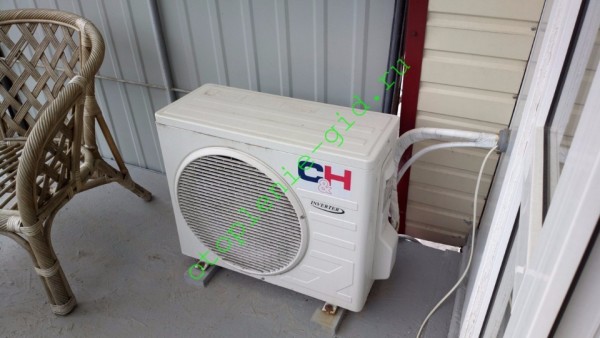
On the picture - external unit split system responsible for heating the attic.
Conclusion
As you can see, even in the absence of mains gas, a house can be heated at moderate costs and without much discomfort. As always, the video in this article will provide you with additional information. I look forward to your additions and comments. Good luck, comrades!
Attention, TODAY only!
